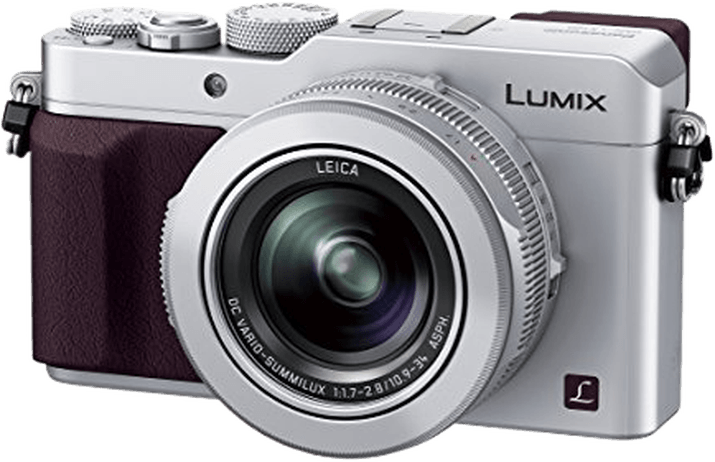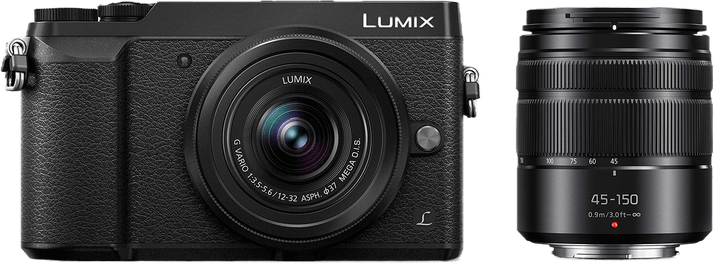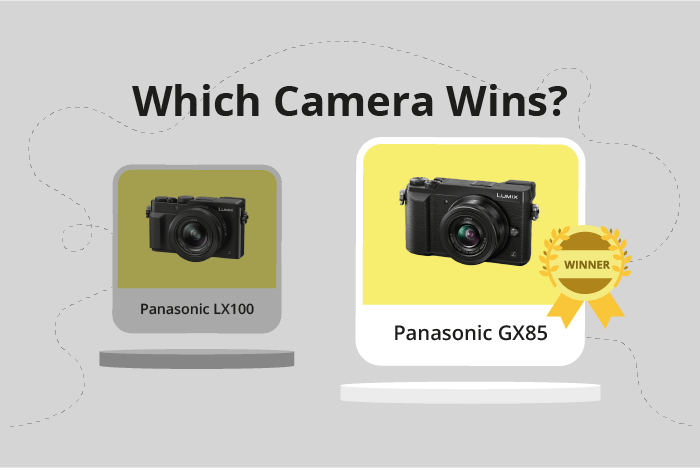Panasonic Lumix DMC-LX100 vs Lumix DMC-GX80 Comparison
Panasonic Lumix DMC-LX100

Panasonic Lumix GX85 (GX80)

The Panasonic Lumix DMC-GX80 takes the lead with a score of 53/100, while the Panasonic Lumix DMC-LX100 follows closely with a score of 49/100. Both cameras share some common specifications, such as being released in the mid-2010s and having similar sizes and weights. However, the DMC-GX80 holds an advantage as a mirrorless camera with a lower launch price of $800 compared to the DMC-LX100’s $899.
On the other hand, the DMC-LX100 is a compact camera, which may be preferable for those seeking a more portable option. Despite the lower score, it still has its merits. Weighing in at 393g, it is slightly lighter than the DMC-GX80 at 426g.
Taking all factors into consideration, the DMC-GX80 emerges as the better camera due to its higher score, mirrorless technology, and lower launch price. However, the DMC-LX100 remains a viable option for those prioritizing portability and a compact design.
Panasonic Lumix DMC-LX100 vs Lumix DMC-GX80 Overview and Optics
The Panasonic Lumix DMC-LX100 wins by a slight margin in our optics comparison, scoring 56/100, while the Panasonic Lumix DMC-GX80 scores 55/100. Both cameras share several specifications, such as the CMOS sensor type, Venus Engine processor, Micro Four Thirds sensor size, and image stabilization.
The LX100 has a few advantages over the GX80, including a faster shooting speed of 11 frames per second compared to the GX80’s 8 frames per second. This makes the LX100 better for capturing fast-moving subjects or action shots. Additionally, the LX100 has a fixed lens mount, which means that users do not need to worry about changing lenses or compatibility issues with different lenses.
On the other hand, the GX80 has a higher megapixel count of 16, compared to the LX100’s 12.8 megapixels. This allows the GX80 to capture images with more detail and higher resolution. Furthermore, the GX80 has a higher DXOMARK sensor score of 71, compared to the LX100’s 67. This means that the GX80’s sensor performs better in terms of color depth, dynamic range, and low-light performance. The GX80 also has a Micro 4/3 lens mount, which offers more flexibility for users who want to change lenses and adapt their camera to different shooting situations.
Taking these points into consideration, the Panasonic Lumix DMC-LX100 is the winner in terms of optics due to its faster shooting speed and the convenience of a fixed lens mount. However, the Panasonic Lumix DMC-GX80 offers advantages in image quality and lens flexibility, making it a strong contender for those who prioritize these features.
Panasonic Lumix DMC-LX100 vs Lumix DMC-GX80 Video Performance
The Panasonic Lumix DMC-GX80 outperforms the Panasonic Lumix DMC-LX100 in video capabilities with a score of 83/100 compared to the LX100’s 70/100. Both cameras share common features, such as 4K video resolution, maximum video dimensions of 3840 x 2160, and built-in time-lapse functionality.
The GX80’s superior video performance stems from its higher maximum video frame rate of 60fps, compared to the LX100’s 30fps. This higher frame rate allows the GX80 to record smoother video, particularly in fast-moving scenes or during slow-motion playback. Additionally, the GX80’s higher score signifies better overall video quality, which may include factors such as color accuracy, dynamic range, and low-light performance.
On the other hand, the LX100 does not have any specific advantages over the GX80 in terms of video capabilities. Both cameras share the same maximum video resolution and dimensions, as well as time-lapse functionality. The only difference is the lower maximum frame rate of the LX100, which results in a lower overall video score.
In comparing the Panasonic Lumix DMC-LX100 and DMC-GX80, it is clear that the GX80 offers superior video performance due to its higher frame rate and overall video quality. The LX100, while still offering 4K video resolution and time-lapse functionality, falls short in comparison to the GX80’s smoother video recording capabilities. Therefore, for users prioritizing video performance, the Panasonic Lumix DMC-GX80 is the better choice.
Panasonic Lumix DMC-LX100 vs Lumix DMC-GX80 Features and Benefits
The Panasonic Lumix DMC-GX80 wins the features comparison with a score of 57/100, while the Panasonic Lumix DMC-LX100 scores 41/100. Both cameras share a 3-inch screen size, lack of GPS, WIFI connectivity, and absence of Bluetooth.
The Lumix DMC-GX80 outshines the DMC-LX100 in screen resolution and touchscreen capabilities. The GX80’s screen resolution is 1,040,000 dots, higher than the LX100’s 921,000 dots. This difference contributes to a clearer and sharper image display on the GX80. Additionally, the GX80 has a touchscreen, making it more user-friendly and allowing for easier navigation through menus and settings.
The Lumix DMC-LX100, despite its lower feature score, has a flip screen. This feature makes it easier for photographers to capture images from various angles and positions. The DMC-GX80 also has a flip screen, so both cameras are on equal footing in this aspect.
In terms of features, the Panasonic Lumix DMC-GX80 is the better camera due to its higher screen resolution and touchscreen capabilities. These advantages result in a more enjoyable user experience and enhanced image display. The DMC-LX100, while not as feature-rich as the GX80, still offers a flip screen that benefits photographers in capturing versatile shots. Both cameras are suitable for various photography needs, with the GX80 having a slight edge in features.
Panasonic Lumix DMC-LX100 vs Lumix DMC-GX80 Storage and Battery
The Panasonic Lumix DMC-LX100 and the Panasonic Lumix DMC-GX80 both have a storage and battery score of 16/100. They share similarities in this aspect, as each camera has one memory card slot and accepts SD, SDHC, and SDXC memory cards. Neither camera offers USB charging.
The LX100 has a slightly better battery life, with 300 shots per charge compared to the GX80’s 290 shots. This difference may not be significant for some users, but it is an advantage for the LX100. The battery types are similar, with the LX100 using a DMW-BLG10E and the GX80 using a DMW-BLG10.
There are no specific advantages for the GX80 in terms of storage and battery. Both cameras have the same score in this category, and the differences between them are minimal. The LX100’s marginally longer battery life may be a deciding factor for some users, but overall, the storage and battery capabilities of these two cameras are quite similar.
Alternatives to the Panasonic Lumix DMC-LX100 and Lumix DMC-GX80
Are you still undecided about which camera is right for you? Have a look at these popular comparisons that feature the Panasonic Lumix DMC-LX100 or the Panasonic Lumix DMC-GX80:

